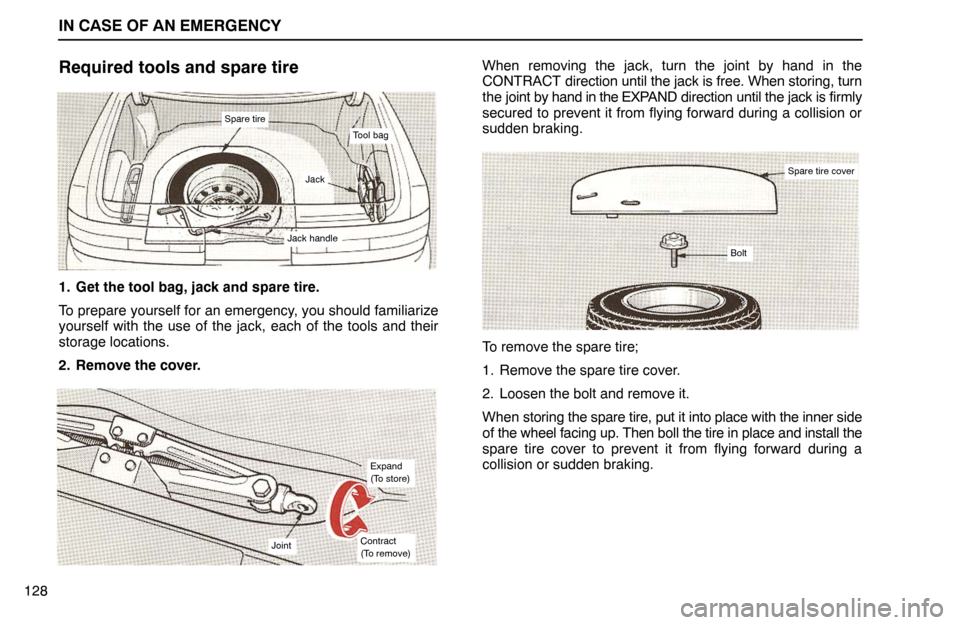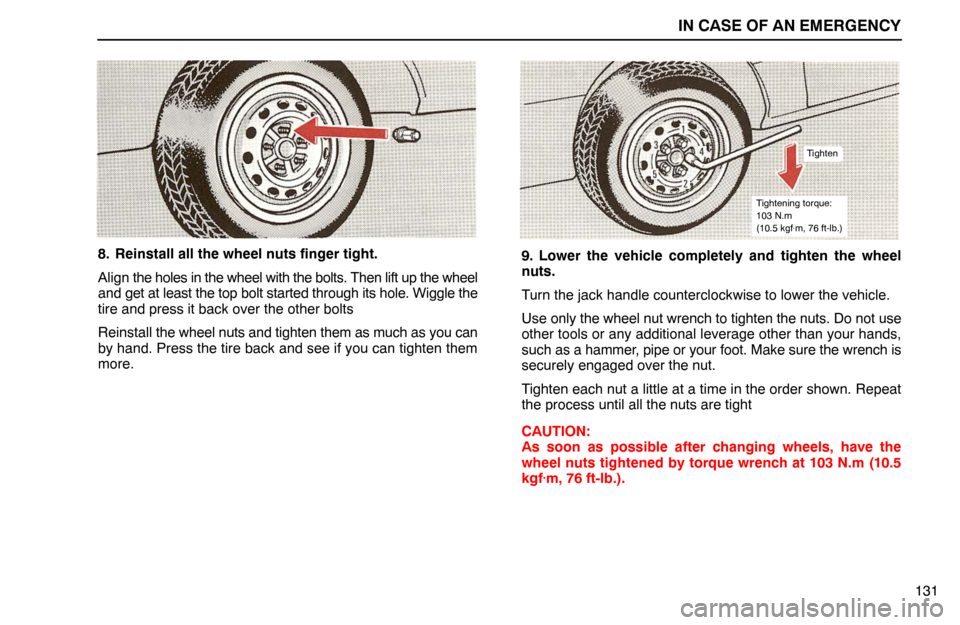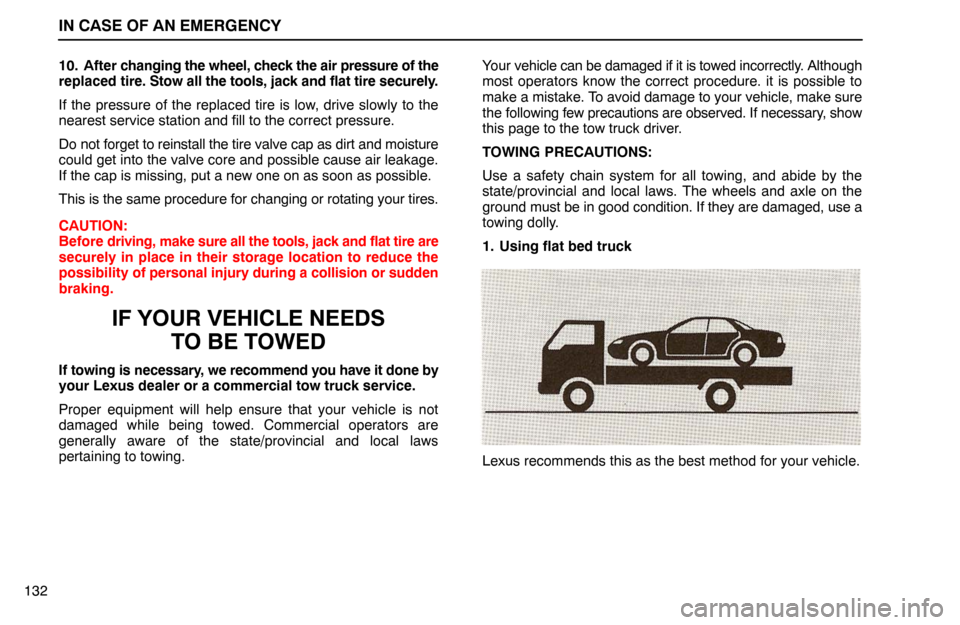ECU Lexus ES300 1992 In Case Of An Emergency
[x] Cancel search | Manufacturer: LEXUS, Model Year: 1992, Model line: ES300, Model: Lexus ES300 1992Pages: 14, PDF Size: 3.31 MB
Page 6 of 14

IN CASE OF AN EMERGENCY
128
Required tools and spare tire
Spare tire
Tool bag
Jack
Jack handle
1. Get the tool bag, jack and spare tire.
To prepare yourself for an emergency, you should familiarize
yourself with the use of the jack, each of the tools and their
storage locations.
2. Remove the cover.
Expand
(To store)
Contract
(To remove)Joint
When removing the jack, turn the joint by hand in the
CONTRACT direction until the jack is free. When storing, turn
the joint by hand in the EXPAND direction until the jack is firmly
secured to prevent it from flying forward during a collision or
sudden braking.
Spare tire cover
Bolt
To remove the spare tire;
1. Remove the spare tire cover.
2. Loosen the bolt and remove it.
When storing the spare tire, put it into place with the inner side
of the wheel facing up. Then boll the tire in place and install the
spare tire cover to prevent it from flying forward during a
collision or sudden braking.
Page 9 of 14

IN CASE OF AN EMERGENCY
131
8. Reinstall all the wheel nuts finger tight.
Align the holes in the wheel with the bolts. Then lift up the wheel
and get at least the top bolt started through its hole. Wiggle the
tire and press it back over the other bolts
Reinstall the wheel nuts and tighten them as much as you can
by hand. Press the tire back and see if you can tighten them
more.
Tighten
Tightening torque:
103 N.m
(10.5 kgf
.m, 76 ft-lb.)
9. Lower the vehicle completely and tighten the wheel
nuts.
Turn the jack handle counterclockwise to lower the vehicle.
Use only the wheel nut wrench to tighten the nuts. Do not use
other tools or any additional leverage other than your hands,
such as a hammer, pipe or your foot. Make sure the wrench is
securely engaged over the nut.
Tighten each nut a little at a time in the order shown. Repeat
the process until all the nuts are tight
CAUTION:
As soon as possible after changing wheels, have the
wheel nuts tightened by torque wrench at 103 N.m (10.5
kgf
.m, 76 ft-lb.).
Page 10 of 14

IN CASE OF AN EMERGENCY
13210. After changing the wheel, check the air pressure of the
replaced tire. Stow all the tools, jack and flat tire securely.
If the pressure of the replaced tire is low, drive slowly to the
nearest service station and fill to the correct pressure.
Do not forget to reinstall the tire valve cap as dirt and moisture
could get into the valve core and possible cause air leakage.
If the cap is missing, put a new one on as soon as possible.
This is the same procedure for changing or rotating your tires.
CAUTION:
Before driving, make sure all the tools, jack and flat tire are
securely in place in their storage location to reduce the
possibility of personal injury during a collision or sudden
braking.
IF YOUR VEHICLE NEEDS
TO BE TOWED
If towing is necessary, we recommend you have it done by
your Lexus dealer or a commercial tow truck service.
Proper equipment will help ensure that your vehicle is not
damaged while being towed. Commercial operators are
generally aware of the state/provincial and local laws
pertaining to towing.Your vehicle can be damaged if it is towed incorrectly. Although
most operators know the correct procedure. it is possible to
make a mistake. To avoid damage to your vehicle, make sure
the following few precautions are observed. If necessary, show
this page to the tow truck driver.
TOWING PRECAUTIONS:
Use a safety chain system for all towing, and abide by the
state/provincial and local laws. The wheels and axle on the
ground must be in good condition. If they are damaged, use a
towing dolly.
1. Using flat bed truck
Lexus recommends this as the best method for your vehicle.
Page 13 of 14

IN CASE OF AN EMERGENCY
135
Emergency towing
FrontRear
Emergency towing eyeletsEmergency towing eyelets
If towing service is not available in an emergency, your
vehicle may be temporarily towed by a cable secured to
one of the eyelets under the front or rear of the vehicle.
A driver must be in the vehicle to steer it and operate the
brakes. Towing in this manner may be done only on
hard-surfaced roads for a short distance and at low speeds.
Also, the wheels, axles, drive train, steering and brakes must
all be in good condition.
Before towing, release the parking brake and put the
transmission in neutral (manual) or “N” (automatic). The
ignition key must be in “ACC” (engine off) or “ON” (engine
running).CAUTION:
If the engine is not running, the power assist for the brakes
and steering will not work so steering and braking will be
much harder than usual.
IF THE MOON ROOF
DOES NOT CLOSE
1. Pull off the moon roof control cover.